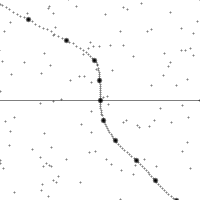Image:Galilean transform of world line.gif
From Wikimedia Commons, the free media repository

No higher resolution available.
Galilean_transform_of_world_line.gif (200 × 200 pixel, file size: 134 KB, MIME type: image/gif)
[edit] Changing views of spacetime along the world line of a slowly accelerating observer
In this animation, the vertical direction indicates time and the horizontal direction indicates distance, the dashed line is the spacetime trajectory ("world line") of the observer. The lower half of the diagram shows the events that are "earlier" than the observer, and the upper quarter shows events that are "later" than the observer. The small dots are arbitrary events in spacetime.
The slope of the world line (deviation from being vertical) gives the relative velocity to the observer. Note how the view of spacetime changes when the observer accelerates.
Compare Image:Lorentz transform of world line.gif, which depicts the situation for rapid acceleration according to special relativity.
[edit] Summary
Source of program used to generate image:
//GPL
#include <stdio.h>
#include <stdlib.h>
#include <math.h>
#define PI 3.141592653589793238462
#define SX 200
#define SY 200
#define PL 100
#define DN 2000
unsigned char img[SX][SY];
double path[PL+1][2], dots[DN][2];
void dodot(int x, int y, double f) {
if(x<0||x>=SX||y<0||y>=SY) return;
img[y][x]*=f;
}
void dospot(int x, int y) {
dodot(x, y, .5);
dodot(x+1, y, .75);
dodot(x-1, y, .75);
dodot(x, y+1, .75);
dodot(x, y-1, .75);
}
void dobigspot(int x, int y) {
int a, b;
for(b=-3;b<=3;++b) for(a=-3;a<=3;++a) if(a*a+b*b<=9) dodot(x+a, y+b, (a*a+b*b)/10.);
}
void dospotd(double t, double x) {
dospot((x+1)*(SX/2.), (-t+1)*(SY/2.));
}
void dosmallspotd(double t, double x) {
dodot((x+1)*(SX/2.), (-t+1)*(SY/2.), .25);
}
void dobigspotd(double t, double x) {
dobigspot((x+1)*(SX/2.), (-t+1)*(SY/2.));
}
int main() {
char fn[100];
int n, x, y, t, i, w;
double a, b, da, db, ta, tb;
FILE *f;
path[0][0]=path[0][1]=0;
for(t=0;t<=PL;++t) path[t][1]=0;
for(n=1;n<10;++n) {
a=rand()%20000/10000.-1; a/=n*n*n*n/200.; b=rand()%20000*(PI/10000);
for(t=0;t<=PL;++t) {
path[t][1]+=a*sin((2*PI/PL)*n*t+b);
}
}
for(t=PL;t>=0;--t) path[t][1]-=path[0][1];
path[0][0]=0;
for(t=1;t<=PL;++t) {
a=path[t][1]-path[t-1][1];
path[t][0]=path[t-1][0]+ 1 /* sqrt(1+a*a) */ ;
}
for(t=0;t<DN;++t) {
a=rand()%20000/10000.-1; b=rand()%20000/10000.-1;
dots[t][0]=a*path[PL][0]/2; dots[t][1]=b*1000;
}
for(n=0;n<100;++n) {
i=PL*n/100;
a=path[i+1][0]-(da=path[i][0]); b=(db=path[i][1])-path[i+1][1]; /* a = 1, this is a galilean transform */
ta=path[PL][0]; tb=path[PL][1];
a/=50.; b/=50.;
for(y=0;y<SY;++y) for(x=0;x<SX;++x) img[y][x]=255;
/*for(y=0;y<SY;++y) img[y][y*SX/SY]*=.5;
for(y=0;y<SY;++y) img[y][(SY-y-1)*SX/SY]*=.5;*/
for(x=0;x<SX;++x) img[SY/2][x]*=.5;
for(w=-20;w<=20;++w)
for(t=0;t<PL;++t) dospotd(a*(path[t][0]-da-w*ta) /* +b*(path[t][1]-db-w*tb) */,
b*(path[t][0]-da-w*ta) +a*(path[t][1]-db-w*tb));
for(w=-20;w<=20;++w)
for(t=0;t<PL;t+=10) dobigspotd(a*(path[t][0]-da-w*ta) /* +b*(path[t][1]-db-w*tb) */,
b*(path[t][0]-da-w*ta) +a*(path[t][1]-db-w*tb));
for(w=-20;w<=20;++w)
for(t=0;t<DN;++t) dospotd(a*(dots[t][0]-da-w*ta) /* +b*(dots[t][1]-db-w*tb) */,
b*(dots[t][0]-da-w*ta) +a*(dots[t][1]-db-w*tb));
//if(n==0) printf("%lf; %lf, %lf, %lf; %lf, %lf, %lf, %lf, %lf\n", a*(path[PL][0]-da-1*ta)+b*(path[PL][1]-db-1*tb), path[PL][0], da, 1*ta, path[PL][1], db, 1*tb, path[0][0], path[0][1]);
sprintf(fn, "gal%04d.pgm", n);
f=fopen(fn, "wb");
fprintf(f, "P5\n%d %d\n255\n", SX, SY);
fwrite(img, 256*256, 1, f);
fclose(f);
}
return 0;
}
[edit] Licensing
File history
Click on a date/time to view the file as it appeared at that time.
| Date/Time | User | Dimensions | File size | Comment | |
|---|---|---|---|---|---|
| (current) | 21:50, 9 November 2006 | Cyp (Talk | contribs) | 200×200 | 134 KB | Source of program used to generate image: <pre>//GPL #include <stdio.h> #include <stdlib.h> #include <math.h> #define PI 3.141592653589793238462 #define SX 200 #define SY 200 #define PL 100 #define DN 2000 unsigned char img[SX][SY]; double path[PL+1][ |
- Edit this file using an external application
(See the setup instructions for more information)
Links
The following pages link to this file:


